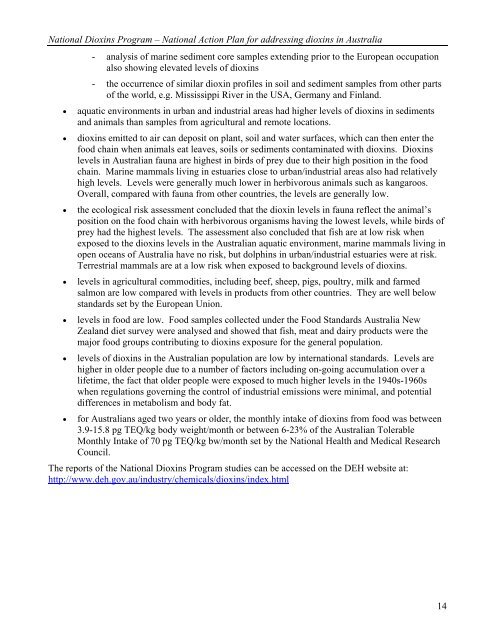National Action Plan for Addressing Dioxins in Australia
National Action Plan for Addressing Dioxins in Australia
National Action Plan for Addressing Dioxins in Australia
- No tags were found...
Create successful ePaper yourself
Turn your PDF publications into a flip-book with our unique Google optimized e-Paper software.
<strong>National</strong> <strong>Diox<strong>in</strong>s</strong> Program – <strong>National</strong> <strong>Action</strong> <strong>Plan</strong> <strong>for</strong> address<strong>in</strong>g diox<strong>in</strong>s <strong>in</strong> <strong>Australia</strong>- analysis of mar<strong>in</strong>e sediment core samples extend<strong>in</strong>g prior to the European occupationalso show<strong>in</strong>g elevated levels of diox<strong>in</strong>s- the occurrence of similar diox<strong>in</strong> profiles <strong>in</strong> soil and sediment samples from other partsof the world, e.g. Mississippi River <strong>in</strong> the USA, Germany and F<strong>in</strong>land.• aquatic environments <strong>in</strong> urban and <strong>in</strong>dustrial areas had higher levels of diox<strong>in</strong>s <strong>in</strong> sedimentsand animals than samples from agricultural and remote locations.• diox<strong>in</strong>s emitted to air can deposit on plant, soil and water surfaces, which can then enter thefood cha<strong>in</strong> when animals eat leaves, soils or sediments contam<strong>in</strong>ated with diox<strong>in</strong>s. <strong>Diox<strong>in</strong>s</strong>levels <strong>in</strong> <strong>Australia</strong>n fauna are highest <strong>in</strong> birds of prey due to their high position <strong>in</strong> the foodcha<strong>in</strong>. Mar<strong>in</strong>e mammals liv<strong>in</strong>g <strong>in</strong> estuaries close to urban/<strong>in</strong>dustrial areas also had relativelyhigh levels. Levels were generally much lower <strong>in</strong> herbivorous animals such as kangaroos.Overall, compared with fauna from other countries, the levels are generally low.• the ecological risk assessment concluded that the diox<strong>in</strong> levels <strong>in</strong> fauna reflect the animal’sposition on the food cha<strong>in</strong> with herbivorous organisms hav<strong>in</strong>g the lowest levels, while birds ofprey had the highest levels. The assessment also concluded that fish are at low risk whenexposed to the diox<strong>in</strong>s levels <strong>in</strong> the <strong>Australia</strong>n aquatic environment, mar<strong>in</strong>e mammals liv<strong>in</strong>g <strong>in</strong>open oceans of <strong>Australia</strong> have no risk, but dolph<strong>in</strong>s <strong>in</strong> urban/<strong>in</strong>dustrial estuaries were at risk.Terrestrial mammals are at a low risk when exposed to background levels of diox<strong>in</strong>s.• levels <strong>in</strong> agricultural commodities, <strong>in</strong>clud<strong>in</strong>g beef, sheep, pigs, poultry, milk and farmedsalmon are low compared with levels <strong>in</strong> products from other countries. They are well belowstandards set by the European Union.• levels <strong>in</strong> food are low. Food samples collected under the Food Standards <strong>Australia</strong> NewZealand diet survey were analysed and showed that fish, meat and dairy products were themajor food groups contribut<strong>in</strong>g to diox<strong>in</strong>s exposure <strong>for</strong> the general population.• levels of diox<strong>in</strong>s <strong>in</strong> the <strong>Australia</strong>n population are low by <strong>in</strong>ternational standards. Levels arehigher <strong>in</strong> older people due to a number of factors <strong>in</strong>clud<strong>in</strong>g on-go<strong>in</strong>g accumulation over alifetime, the fact that older people were exposed to much higher levels <strong>in</strong> the 1940s-1960swhen regulations govern<strong>in</strong>g the control of <strong>in</strong>dustrial emissions were m<strong>in</strong>imal, and potentialdifferences <strong>in</strong> metabolism and body fat.• <strong>for</strong> <strong>Australia</strong>ns aged two years or older, the monthly <strong>in</strong>take of diox<strong>in</strong>s from food was between3.9-15.8 pg TEQ/kg body weight/month or between 6-23% of the <strong>Australia</strong>n TolerableMonthly Intake of 70 pg TEQ/kg bw/month set by the <strong>National</strong> Health and Medical ResearchCouncil.The reports of the <strong>National</strong> <strong>Diox<strong>in</strong>s</strong> Program studies can be accessed on the DEH website at:http://www.deh.gov.au/<strong>in</strong>dustry/chemicals/diox<strong>in</strong>s/<strong>in</strong>dex.html14
















